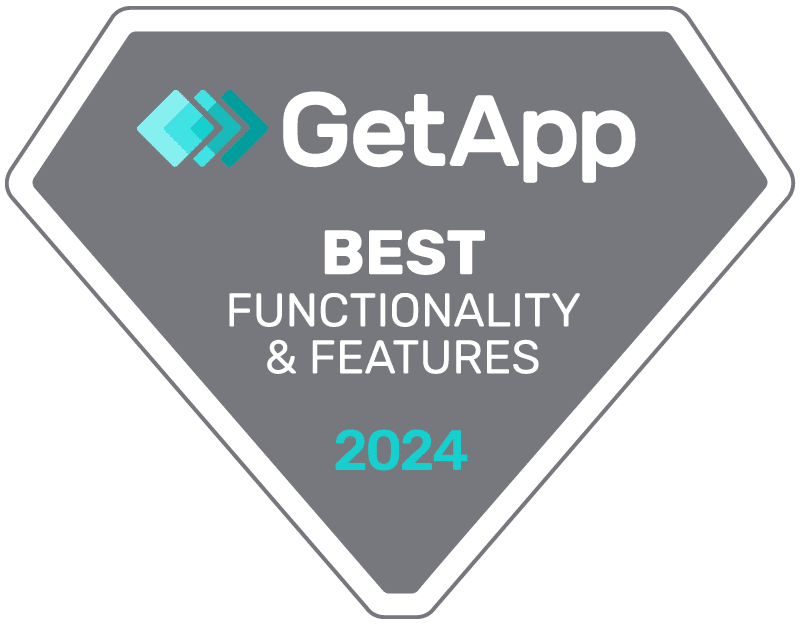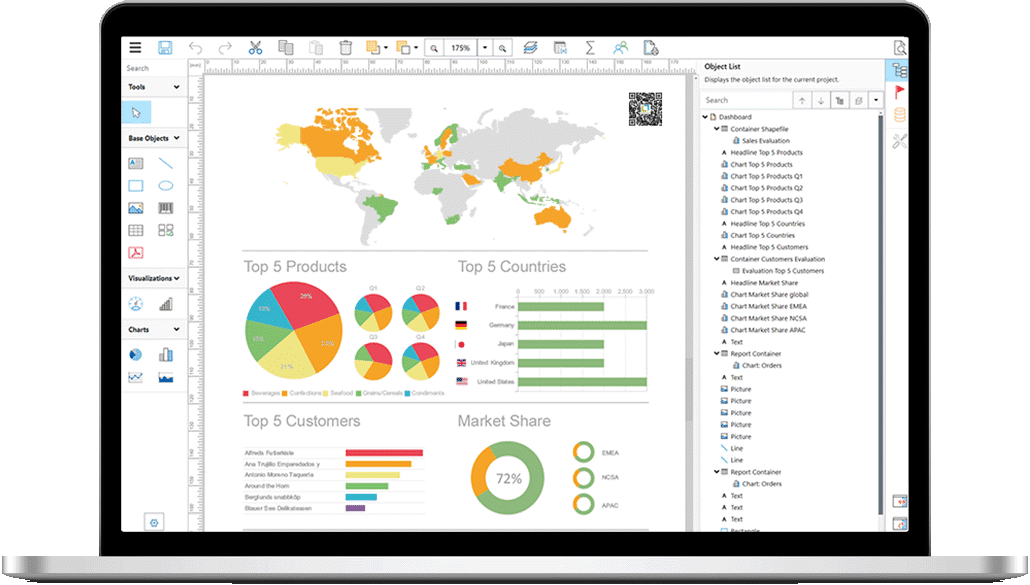Reporting capabilities for your software
Build or Buy
Why CTOs choose List & Label
Every engineering roadmap has a silent drain on time, budget, and team morale: infrastructure that your users expect but which doesn’t differentiate your product. Reporting is often one of those things.
While your team can build a custom reporting system, the real question is: should they?
This guide lays out why modern engineering leaders choose to buy List & Label rather than roll their own reporting layer—and how that decision reduces risk, accelerates delivery, and aligns with long-term business goals.
Strategic engineering requires ruthless prioritization
Not everything you could build is worth building.
When your team builds custom reporting, they divert energy from product features that actually drive market differentiation. Worse, those investments compound over time: maintenance, scaling, UI bugs, export quirks, accessibility fixes—none of which your users will thank you for.
List & Label provides a mature, feature-complete reporting engine with deep integration options. Your developers can plug it in, configure it, and move on—with the peace of mind that reporting is handled reliably.
Accelerate time-to-market without cutting corners
In a competitive market, speed wins.
Integrating List & Label typically takes a few days—not months. Your team avoids multi-sprint delays building visual designers, implementing rendering engines, or writing export pipelines. This faster path to first value helps:
- Meet release deadlines
- Free up roadmap capacity
- Shorten customer feedback loops
While internal builds often struggle to pass QA and UX benchmarks, List & Label is production-ready out of the box.
Total cost of ownership: build is never free
| Cost category | DIY (build) | List & Label (buy) |
|---|---|---|
| Compliance & export | Build/test every output format manually | Supported natively (PDF/A, etc.) |
| Developer time | 3000–3500 hours (initial build) | ~1–2 days integration |
| Maintenance | Ongoing bug fixes, edge cases, updates | Handled by vendor |
| Opportunity cost | Slower roadmap, delayed features | Teams stay focused on core value |
| User enablement | Custom UI work, documentation | WYSIWYG designer, royalty-free |
List & Label is not just a purchase — it’s a resource multiplier.
Reduce risk with a vendor you can trust
Custom-built platforms age fast. Team churn, shifting frameworks, and unclear code ownership can all create tech debt. List & Label offers:
- 30+ years of stable product evolution
- Regular updates and security patches
- Professional support direct from the vendor
- Full control through extensible APIs
It’s not just faster—it’s safer.



Reporting features your users will love
(and your team won’t have to build)
Out of the box, List & Label includes:
- Multiple embeddable report designers (no license cost for end user)
- Tables, charts, gauges, maps, crosstabs, barcodes and much more
- Support for over 40 databases and data sources
- Interactive elements (expand, sort, drilldown, report parameters)
- Around 30 export formats (PDF/A, Excel, HTML, images, etc.)
That’s years of dev time, delivered in days.


Built for enterprise environments
Your tech stack doesn’t need to bend for List & Label. It supports:
- .NET (WinForms, WPF, ASP.NET, Blazor)
- C++ and Delphi
- Angular, React, Vue
- Windows, Linux, macOS, iOS, Android deployment (via List & Label Cross Platform)
List & Label is not a one-off tool. It’s a scalable, enterprise-grade reporting foundation that evolves with your product.
Summary: strategic value at every level
| Objective | List & Label delivers |
|---|---|
| Budget predictability | Royalty-free redistribution, no user-based fees |
| Engineering focus | Devs build product features, not plumbing |
| Operational efficiency | No hidden tech debt, fewer bugs, faster QA cycles |
| Stakeholder confidence | Vendor track record, security compliance, full docs |
| Strategic fit | Aligns with modern CI/CD, DevOps, and cloud setups |
| Time-to-market | Production-ready reporting in days |
Build vs. buy checklist: embedded reporting in your app
| Cost category | DIY (build) | List & Label (buy) |
|---|---|---|
| Flexibility / customization | Full control, but every new feature is a new project | Customizable Designer (desktop + web), DOM API, 230+ formula functions |
| End User capabilities | Limited unless you invest in building UI | Drag-and-drop WYSIWYG Designer, subreports, export previews |
| Integration with dev stack | Must match your stack exactly | Works with .NET 8-10, .NET Framework, Delphi, C++, JS (React/Vue/Angular), Docker, Azure |
| Deployment model | Must be engineered | Offers xcopy, ClickOnce, Docker support, Azure App Services compatibility |
| Data source compatibility | Manual connection logic | 40+ built-in data providers (SQL, NoSQL, REST, XML, JSON) + custom source support |
| Advanced visuals | Every chart or map requires new dev effort | Built-in charts, maps, gauges, crosstabs, conditional formatting, interactivity |
| Security & licensing | You decide, but carry the risk | License-compliant redistribution; built-in security features like role-based access |
| Scalability | Depends on architecture you build | Scales with your app, supports cloud and server-based setups (Report Server) |
| Future-proofing | High technical debt risk | Regular updates to support new platforms, export formats, and IDEs |
To sum it up
You hire developers to solve high-impact problems and not to recreate Excel exports and chart libraries. Buying List & Label isn’t just the faster option. It’s the strategic one.
Explore our reporting tool in action
See what you can build with List & Label in our interactive online demo. Or try List & Label with your own data using the free trial version.
Continue with our other developer guides
FAQ
TL;DR: Developing your own reporting is complex and expensive. It also consumes time that would be better spent on features that differentiate your product.
Reporting functions are one of the invisible infrastructure tasks that all end users expect, but rarely appreciate. Engineering teams must develop many functional areas: visual designers, rendering engines, export formats, data connections, UI components, performance optimization, accessibility, error handling, and security requirements. These tasks cause teams to stray from their actual product priorities and accumulate technical debt over the years.
Another critical aspect is long-term maintenance. Reporting includes many edge cases, different devices, complex data models, compatibility requirements, and the continuous development of export standards. These must be maintained manually in in-house solutions, which causes high follow-up costs.
Additionally, in-house development typically extends the time-to-market, as several sprints are necessary to build basic functionality. Companies that buy reporting instead of building it can deliver releases faster, free up team capacity, and minimize risks.
TL;DR: List & Label offers a ready-to-use reporting stack that saves time, reduces maintenance costs, and provides professional features.
It delivers a complete reporting engine that includes visual report designers, export modules, data provider, visualizations, and API connections. This eliminates the need to build your own report designer, rendering engine, and various export formats.
A key advantage is stability. The product has been continuously developed for over 30 years and regular updates, security adjustments, and technical support are provided directly by combit. This mitigates long-term risks caused by team changes, framework updates, or growing codebases.
Furthermore, List & Label can be flexibly integrated into existing architectures – including .NET, Delphi, C++, JavaScript frameworks, and cross-platform deployment. This allows teams to focus on their core functions because the reporting infrastructure is reliably handled by the tool.
TL;DR: Integration takes a few days, while in-house reporting development often takes months.
A reporting system consists of many components: UI designers, visualization components, export logic, data connections, preview mechanisms, and QA testing, among others. With in-house solutions, these components must first be conceptualized, developed, and tested. This delays roadmap goals and extends feedback cycles.
List & Label already provides these components fully implemented. Teams can generate functional reports within days, provide designers, and gather initial customer feedback. The engineering focus shifts from infrastructure tasks to differentiating product functions.
This faster delivery facilitates release planning, reduces technical risks, and improves planning reliability for stakeholders.
TL;DR: In-house development incurs high initial and follow-up costs, while List & Label takes care of ongoing maintenance.
In-house development typically costs 3,000–3,500 developer hours for the first version alone. This is followed by maintenance costs, bug fixes, browser or framework updates, new export requirements, and support for additional data sources. On top of that, there are opportunity costs from missed feature development in the core business.
List & Label drastically reduces these costs because the essential functional components are already fully implemented. Updates, support, new export formats, and feature expansions are centrally provided by the vendor. Companies benefit from predictable license costs instead of open-ended development budgets.
TL;DR: Designer, charts, maps, crosstabs, drilldowns, support for over 40 data sources, and professional export formats.
List & Label offers an extensive set of features ready for immediate use:
- WYSIWYG designer for desktop and web that can be passed on to customers at no additional cost
- Charts, gauges, and map visualizations
- Crosstab, drilldown navigation, and parameter dialogs
- Support for SQL, NoSQL, REST, XML, JSON, and other sources
- Export formats such as PDF/A, Excel, HTML, images, and more
- Interactive report functions like expandable regions
- Role and rights management
These features save several work months compared to in-house development and eliminate complex QA processes.
TL;DR: List & Label supports .NET, C++, Delphi, web frameworks, and cross-platform deployment.
The reporting framework integrates with modern desktop, server, and cloud environments. Supported environments include:
.NET (WinForms, WPF, ASP.NET, Blazor), C++, Delphi,
JavaScript frameworks like Angular, React, Vue,
Windows, Linux, macOS, iOS, and Android deployments.
For many companies, flexibility is crucial because reporting is a foundational function that must scale over time. Thanks to its API concept, DOM model, and cross-platform components, List & Label remains expandable in the long term.
TL;DR: Less risk, higher productivity, better predictability.
The strategic benefit lies in focusing engineering capacity on innovation and customer value. Instead of allocating internal resources to export logic, designer bugs, or data connections, companies can iterate faster and deliver product-relevant functions.
List & Label minimizes technical risk, provides regular security updates, enables consistent QA processes, supports modern CI/CD pipelines, and remains compatible with new platform versions over time. Reduced operational overhead increases productivity and enables more successful roadmap execution.


